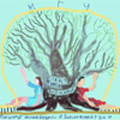Acholeplasma laidlawii strain PG-8A
Acholeplasma laidlawii is found in soil, compost, wastewaters, cell cultures as well as in human tissues and in many animal species (birds, bovine, goat, equine, ovine, porcine, feline, rodent, primates). All of Acholeplasma species tested contain glycolipids and as well as a specific lipoglycan. Acholeplasma species are capable of de novo biosynthesis of carotenoids localized exclusively in the cell membrane. Within the Mollicutes group only the sterol-nonrequiring Acholeplasma has the ability to synthesize saturated fatty acids de novo. Acholeplasma laidlawii is capable of synthesizing glucose using a pyrophosphate-dependent 6-phosphofructokinase which has also been detected in other acholeplasmas (a good example of flexible metabolism).
The Russian discovery:Acholeplasma laidlawii - is the first Russian bacterial genome (2008). Sequencing and proteomics: Institute of Physico-Chemical Medicine; annotation: IITP: ~1,5 Mb; ~1400 genes. Established function for ~80% genes; metabolic reconstruction.
Other features of Acholeplasma laidlawii:
- the absence of a cell wall
- the absence of flagella
- facultative anaerobic
- the optimum growth temperature is 30 to 37 degrees Celsius
- circular DNA
- cholesterol is not required for growth
Acholeplasma laidlawii strain PG-8A
| Size | 1,5 Mbp (1,496,992 bp) |
| Genes | 1433 |
| Coding sequences | 1380 |
| Coding density | 90.62% |
| Average gene length | 983 bp |
G + C content
| Global | 31.92% |
| In coding sequences | 32.22% |
The genome of A. laidlawii is represented by a single 1,496,992-bp circular chromosome with an average G+C content of 31 mol%. This is the longest genome among the Mollicutes with a known nucleotide sequence. It contains genes of polymerase type I, SOS response, and signal transduction systems, as well as RNA regulatory elements, riboswitches, and T boxes. This demonstrates a significant capability for the regulation of gene expression and mutagenic response to stress. Acholeplasma laidlawii and phytoplasmas are the only Mollicutes known to use the universal genetic code, in which UGA is a stop codon. Within the Mollicutes group, only the sterol-nonrequiring Acholeplasma has the capacity to synthesize saturated fatty acids de novo. Proteomic data were used in the primary annotation of the genome, validating expression of many predicted proteins. We also detected posttranslational modifications of A. laidlawii proteins: phosphorylation and acylation. Seventy-four candidate phosphorylated proteins were found: 16 candidates are proteins unique to A. laidlawii, and 11 of them are surface-anchored or integral membrane proteins, which implies the presence of active signaling pathways. Among 20 acylated proteins, 14 contained palmitic chains, and six contained stearic chains. No residue of linoleic or oleic acid was observed. Acylated proteins were components of mainly sugar and inorganic ion transport systems and were surface-anchored proteins with unknown functions.
Acholeplasma laidlawii may contaminate bovine serum and also occurs in serum-free cell culture media products. Unsubstantiated evidence of A. laidlawii contamination of tryptone soya broth existed for some years prior to proof of the organism's contaminating nutrient broth powders. The presence of A. laidlawii in broth powders is a serious problem in routine biopharmaceutical operations where filtration is used as a sterilisation procedure. A. laidlawii may flourish and survive for prolonged periods at refrigeration and ambient tempratures in serum-free cell culture media.
Scientific classification
Kingdom: Bacteria
Division: Firmicutes
Class: Mollicutes
Order: Acholeplasmatales
Family: Acholeplasmataceae
Genus: Acholeplasma
Species: Acholeplasma laidlawii
Acholeplasma laidlawii PG-8A
Request on PubMed
English article posted on PubMed.
Русская версия
The Russian version of this article.


References
© Eugenia Prokhorova 2011
